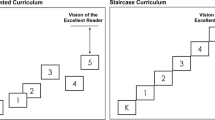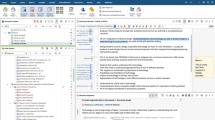Abstract
In the school based subject of design and technology (D&T) a fundamental element is designing and making functional products using critical and creative thinking whilst developing skills in the use of a variety of processes and materials. Teachers of the subject need to be more then just ‘enthusiastic’ about the processes involved if they are to develop enthusiasm in their pupils that will sustain them through the exciting but sometimes arduous and difficult processes required to achieve outcomes of which they and their teachers can be proud. The intention of this research project, using an initial sample of forty-nine students and a non-probability purposive sample of ten students studying to become D&T teachers was to tease out the factors which appear to enable some students to be passionate about creating a product to a given brief while others from similar backgrounds and expectations, given the same brief, and in the same learning situation, do not reach this level of enthusiasm. The data collection method used was an attitude scale and semi-structured interviews which were qualitatively analysed in order to identify factors involved, with the intention of informing and improving the way the authors teach their students, to design, and about design, with the additional aim of improving the students teaching of that activity once they become D&T teachers. Within the full paper results are discussed and tentative conclusions drawn.

Similar content being viewed by others
References
Amabile, T. M. (1997). Motivating creativity in organizations: On doing what you love and loving what you do. California Management Review, 40(1), 39–58.
Atkinson, S. (1997). Identification of some causes of demotivation amongst key stage 4 pupils studying design and technology. Ph.D. thesis, Newcastle-upon-Tyne: Newcastle University.
Atkinson, S. (2000). Does the need for high levels of performance curtail the development of creativity in design and technology project work? International Journal of Technology and Design Education, 10, 255–281.
Atkinson, S. (2003). The relationship between learning style preference, attitude to learning, appropriate prior knowledge and achievement in the context of computer aided learning in electronics. In S. Armstrong, et al. (Eds.), Bridging theory and practice—European learning styles information network 8th conference (pp. 29–40). Hull: Hull University.
Atkinson, S. (2007). A study into attitudes of D&T teacher trainees at Sunderland University to cultural diversity and pluralism. Sunderland: Sunderland University Research Conference.
Atkinson, S. (2008). New intake—New challenges. In D. Kipperman, O. Dagan, & M. J. de Vries (Eds.), PATT20 critical issues in technology education (pp. 50–63). ORT Israel: Tel-Aviv.
Atkinson, S. (2009). Are design and technology teachers able to meet the challenges inherent in the theme for this conference ‘D&T—A platform for success’? In E. Norman (Ed.). Design and Technology Education: International Journal, 14(3), 8–20.
Atkinson, S. (2011). The relationship between the time spent studying subject knowledge and the attitude of trainee teachers to the subject(s) they will teach’. In D. Cheek & J. Streichler (Eds.). The Journal of Technology Studies, 37(1), 17–30. http://scholar.lib.vt.edu/ejournals/JOTS/v37/v37n1. Accessed January 10, 2013.
Atkinson, S., Hardy, A., & Knox, J. (2011). Performance/ability differences between those trained as design and technology teachers on undergraduate (UG) and postgraduate (PG) initial teacher training (ITT) programmes. In K. Stables & C. Benson (Eds.), PATT25/CRIPT8 perspectives on learning in design and technology education (pp. 24–33). London: Goldsmiths College.
Atkinson, S., & Sandwith, A. (2012). A passion for designing. In T.Ginner, J. Hallstrom & M. Hulten (Eds.), PATT26: Technology education in the 21st century (pp. 39–46). Stockholm: Linkoping University.
Bailey, P. (2012). To what extent does the pedagogy adopted by trainee teachers affect children’s creativity in primary design and technology activities? In T. Ginner, J. Hallstrom & M. Hulten (Eds.), PATT26: Technology education in the 21st century (pp. 47–56). Stockholm: Linkoping University.
Baynes, K. (2013). Models of change. Loughborough: Loughborough Design Press.
Beghetto, R. A. (2005). Does assessment kill student creativity? The Educational Forum, 69, 254–263.
Belitz, C., & Lundstrom, M. (1998). The power of flow. New York: Three Rivers Press.
Benson, C. (2009). Working together: Primary and secondary teacher liaison. In A. Bekker (Ed.), PATT-22 2009. Netherlands: Delft.
Benson, C. (2012). The development of quality design and technology in English primary schools: Issues and solutions. In T. Ginner, J. Hallstrom & M. Hulten (Eds.), PATT26: Technology education in the 21st century (pp. 81–88). Stockholm: Linkoping University.
Benson, C., & Lunt, J. (2011). I’m Choosing Purple Not Pink. In K. Stables, C. Benson, & M. De Vries (Eds.), PATT25/CRIPT8 perspectives on learning in design and technology education (pp. 83–91). London: University of London.
Browne, M. N. (2000). The importance of critical thinking for student use of the Internet. College Student Journal, September 1–5. https://castl.duq.edu/Conferences/Library03/PDF/Critical_Thinking/Browne_M.pdf. Accessed January 12, 2012.
Cross, N., Naughton, J., & Walker, D. (1981). Design method and scientific method. Design Studies, 4(2), 195–201. http://design.open.ac.uk/cross/documents/Designmethodandscience.pdf. Accessed January 20, 2013.
Czikszentmihalyi, M. (1990). Flow: The psychology of optimal experience. New York: Harper Collins.
Department for Education and Science and the Welsh Office. (1989). Design and technology for ages 5 to 16: Proposals. London: HMSO.
Department for Education and Skills (DfES). (2004). Key stage 3 national sreategy: Design and technology. London: DfES, HMSO.
Frijda, N. H. (2000). The psychologists’ point of view. In M. Lewis & J. Haviland-Jones (Eds.), Handbook of emotions (2nd ed., pp. 59–74). New York: The Guilford Press.
Fritz, A. (1998). Creativity: From philosophy to practice—Keynote address: IDATER 98. http://www.21learn.org/cats/testing/fritztxt.html. Accessed April 10, 2012.
Goleman, D., Kaufman, P., & Ray, M. (1992). The creative spirit. New York: Penguin Books.
Hamilton, W. (2007). Constructing classroom learning environments that are interactive and authentic and aim for learner empowerment. In E. W. L. Norman & D. Spendlove (Eds.), Linking learning: DATA Education and international research conference (pp. 27–36). Wellesbourne: The Design and Technology Association.
Higgins, C. (2012). Exam reform will destroy UK’s creative economy—Arts leaders’. The Guardian Newspaper 03.11.12. London & Manchester, 1 and 11.
Hope, G. (2012). Transformation by design. In T. Ginner, J. Hallstrom & M. Hulten (Eds.), PATT26: Technology education in the 21st century (pp. 223–231). Stockholm: Linkoping University.
HyperRESEARCH. (2010). HyperRESEARCH Tutorials, Randolph MA 02368-1258, ResearchWare, Inc.
Jeffrey, B., & Wood, P. (2003). The creative school. London: Routledge Falmer.
Lawler, T., McTaminey, A., de Brett, S., & Lord, A. (2012). Design mentoring and designerly attitudes. In T. Ginner, J. Hallstrom & M. Hulten (Eds.), PATT26: Technology education in the 21st century (pp. 262–273). Stockholm: Linkoping University.
Leblanc, T. (2012). Problem finding and problem solving. In S. Garner & C. Evans (Eds.), Design and designing: A critical introduction (pp. 32–49). London: Berg Publisher.
Leonard, D., & Swap, W. (1999). When sparks fly: Igniting creativity in groups. Boston, MA: Harvard Business School Press.
Lewis, T. (1999). Research in technology education: Some areas of need. Journal of Technology Education, 10(2), 41–56.
Likert, R. (1932). A technique for the measurement of attitudes. Archives of Psychology, 140, 1–55.
McLellan, R., & Nicholl, B. (2008). The importance of classroom climate in fostering student creativity in design and technology lessons. In E. W. L. Norman & D. Spendlove (Eds.), Inspiring, developing and supporting excellence in design and technology education for all: The design and technology association research conference (pp. 29–38). Wellesbourne: The Design and Technology Association.
Miller, J. (2012). What is wrong with D&T? London: Royal Society of Arts. http://www.thersa.org/action-research-centre/enterprise-and-design/design/design-in-the-school-curriculum. Accessed January 13, 2013.
Miles, M. B., & Huberman, A. M. (1994). Qualitative data analysis. Thousand Oaks, California: Sage Publications.
Musta’amal, A. H., Norman, E., & Hodgson, T. (2009). Observing creative behaviours. In E. W. L. Norman & D. Spendlove (Eds.), A platform for success: The design and technology association research conference (pp. 59–68). Wellesbourne: The Design and Technology Association.
Ochse, R. (1990). Before the gates of excellence: The determinants of creative genius. Cambridge: Cambridge University Press.
Office for Standards in Education. (1998). Secondary education 1993-97: A review of secondary schools in England. London: Stationary Office.
Office for Standards in Education. (2000). Subject reports secondary design and technology, 1999-2000. London: Stationary Office.
Polanyi, M. (1958). Personal knowledge: Towards a post-critical philosophy. Chicago: The University of Chicago Press.
Polanyi, M. (1966). The tacit dimension. New York: Anchor Doubleday.
Reeve, E. M. (2011). Forward. In S. A. Warner & P. R. Gemmill (Eds.). Design and creativity in technology and engineering education. Reston: Council on Technology Teacher Education. http://www2.tec.ilstu.edu/students/Technology_Education_Resources/Complete_Yearbook_Final.doc. Accessed July 2013.
Robinson, K. (Ed.) (1999). All our futures: Creativity, culture and education. Report from National Advisory Committee on Creative and Cultural Education, London, Department for Education and Employment. http://www.creativitycultureeducation.org. Accessed January 11, 2013.
Robson, C. (1993). Real world research. Oxford: Blackwell.
Rogers, M., & Fasciato, M. (2005). Can creativity be assessed? British Educational Research Association Annual Conference. Pontypridd: University of Glamorgan. http://www.leeds.ac.uk/educol/documents/150029.htm. Accessed January 10, 2012.
Rosengren, C. (2004). The occupational adventure guide: A travel guide to the career of your dreams. [Online e-book] http://www.passioncatalyst.com/oag/. Accessed January 11, 2013.
Stables, K. (2012). Designerly well-being: Can mainstream schooling offer a curriculum that provides a foundation for developing the lifelong design and technological capability of individuals and societies? In T. Ginner, J. Hallstrom, & M. Hulten (Eds.), PATT26: Technology education in the 21st century (pp. 425–433). Stockholm: Linkoping University.
Stricker, D. R. (2011). The many forms of creative expression, In S. A. Warner & P. R. Gemmill (Eds.). Design and creativity in technology and engineering education (Chap. 3). Reston: Council on Technology Teacher Education. http://www2.tec.ilstu.edu/students/Technology_Education_Resources/Complete_Yearbook_Final.doc. Accessed July 2013.
Terenzini, P. T., Springer, L., Pascarella, E. T., & Nora, A. (1995). Academic and out-of-class influences on students’ intellectual orientations. The Review of Higher Education, 19(1), 23–44.
Toft, P. (2007). Design and technology: Seeing both the wood and the trees. In D. Barlex (Ed.), Design & Technology: For the next generation (pp. 266–294). Whitchurch: Cliffeco Communications.
Tovey, M. (2012). The passport to practice’. In S. Garner & C. Evans (Eds.), Design and designing: A critical introduction (pp. 5–19). London: Berg Publisher.
Trebell, D. (2007). A literature review in search of an appropriate theoretical perspective to frame a study of designerly activity in secondary design and technology. In E. W. L. Norman & D. Spendlove (Eds.), DATA international research conference: Linking learning (pp. 91–95). Loughborough: Loughborough University.
Virtanen, S., Leponiemi, T., & Rasinen, A. (2012). Design and assessment in technology education: The ‘Birdhouse Band’ project. In T. Ginner, J. Hallstrom, & M. Hulten (Eds.), PATT26: Technology education in the 21st century (pp. 425–433). Stockholm: Linkoping University.
Wu, T. F., Custer, R. L., & Dyrenfurth, M. J. (1996). Technological and personal problem solving styles: Is there a difference? Journal of Technology Education, 7(2). http://scholar.lib.vt.edu/ejournals/JTE/jte-v7n2/wu.jte-v7n2.html. Accessed January 11, 2013.
Author information
Authors and Affiliations
Corresponding author
Rights and permissions
About this article
Cite this article
Atkinson, S., Sandwith, A. Passionate about designing. Int J Technol Des Educ 24, 163–186 (2014). https://doi.org/10.1007/s10798-013-9251-y
Accepted:
Published:
Issue Date:
DOI: https://doi.org/10.1007/s10798-013-9251-y




